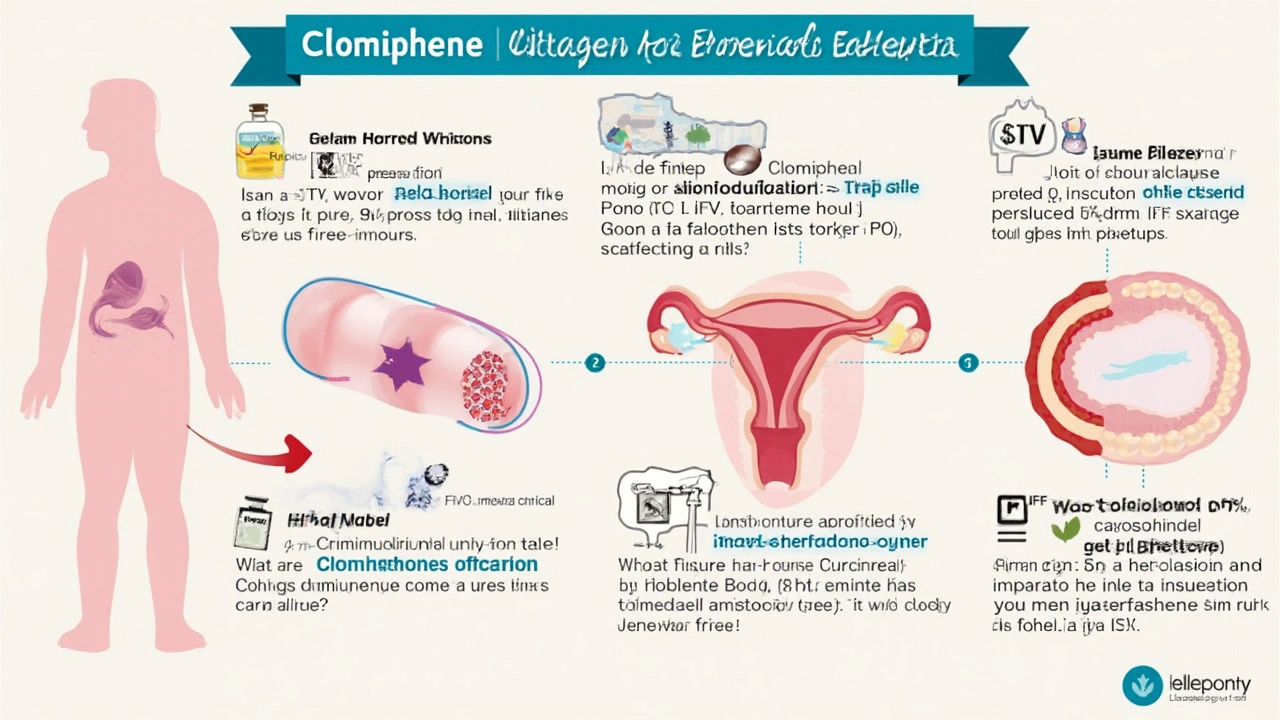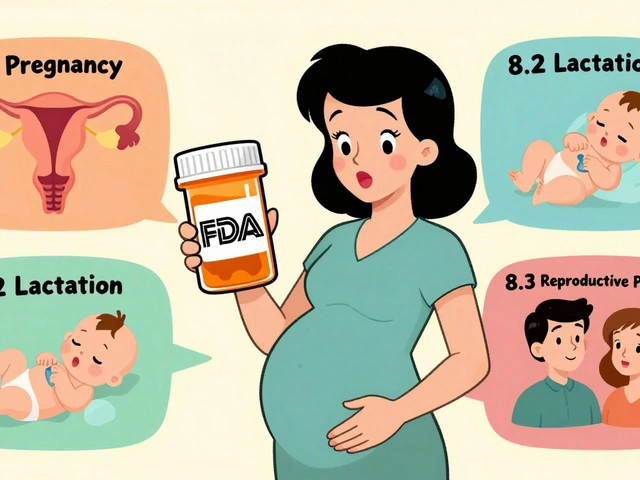So, you're here because you've heard about Clomiphene, a drug usually linked with ovulating issues, and are wondering if it could help with tubal factor infertility. Curious, right? Let's break it down. Clomiphene is great at encouraging ovulation in women who aren't ovulating regularly. It's like giving the ovaries a gentle nudge to do what they're supposed to do every month.
Now, here's where the twist comes in. Tubal factor infertility involves problems with the fallopian tubes—those tiny passageways connecting the ovaries to the uterus. If they're blocked or damaged, the meeting of egg and sperm just doesn't happen naturally. It's a different ball game than a typical ovulatory problem, which Clomiphene addresses.
- Understanding Clomiphene and Its Primary Use
- Tubal Factor Infertility Explained
- Clomiphene's Role in Infertility Treatment
- Comparing Clomiphene with Other Treatments
- Considerations and Tips for Couples
Understanding Clomiphene and Its Primary Use
Let's get down to the basics of Clomiphene, this popular fertility aid. First off, it's worth noting that Clomiphene Citrate, often simply called Clomid, is one of the go-to drugs for treating ovulatory dysfunction. Pretty much, if you're not ovulating as you should, this is likely the first thing your doctor might suggest.
How does it work exactly? Well, think of Clomiphene as your hormonal coach. It basically tricks your brain into thinking that estrogen levels are low, prompting the pituitary gland to produce more follicle-stimulating hormone (FSH) and luteinizing hormone (LH). These two hormones are key players when it comes to stimulating your ovaries to release eggs.
Interesting fact: More than 70% of women with ovulatory issues can expect Clomiphene to help them ovulate. This little pill is usually taken for five days early in the menstrual cycle, often starting on the third, fourth, or fifth day after the start of your period. A typical course runs for about three to six months, with close monitoring to see how your body responds.
A common question that pops up is about side effects. Of course, with any medication, there are some, but they're usually mild. Some women mention mood swings, hot flashes, or bloating. A rare but noted side effect is multiple pregnancies; around 7-8% of Clomiphene pregnancies end up as twins, so it's something to keep in mind.
People often think of Clomiphene when they hear about fertility treatment, but it's crucial to know that it mainly helps those with ovulatory problems. It won't do much if the infertility issue lies elsewhere, like with tubal factor infertility.
Tubal Factor Infertility Explained
Been hearing the term tubal factor infertility and wondering what exactly it means? Well, it's all about the fallopian tubes. These little tubes are super important in the baby-making process because they act as a pathway for the egg to travel from the ovary to the uterus. But when there's a blockage or damage, it throws a wrench in the works.
What Causes Tubal Factor Infertility?
There are a couple of culprits behind this type of infertility. A big one is pelvic inflammatory disease, often resulting from sexually transmitted infections like chlamydia or gonorrhea. This can cause scarring and blocks in the tubes.
Another typical cause is endometriosis, a condition where tissue similar to the lining inside the uterus grows outside it, sometimes affecting the tubes. And, let's not forget previous surgeries or ectopic pregnancies that might lead to further complications.
How Common Is It?
You might be surprised to learn how common this is. Around 25% to 35% of female infertility cases stem from tubal factors. That's a big chunk! Knowing the cause helps in understanding what might be the best treatment approach.
| Tubal Factor Infertility Facts |
|---|
| Affects 25% - 35% of female infertility cases |
| Often linked with pelvic inflammatory disease |
| Endometriosis is a common cause |
Detection and Diagnosis
Diagnosing tubal factor infertility usually involves some tests. The most common one is the hysterosalpingography (HSG), which checks if the tubes are open. It's a bit like an X-ray, but with a special dye injected to see the flow through the tubes.
Some doctors might also use laparoscopy, a minimally invasive surgery, to get a direct look. Knowing the condition of the tubes is crucial to planning the best next steps.
What Does It Mean for Treatment?
Unlike simple ovulation issues where Clomiphene might do the trick, tubal problems are a different story. Treatments could be more hands-on, like laparoscopic surgery to clear blockages. In cases where surgery isn't viable, in vitro fertilization (IVF) might be the best bet, as it bypasses the tubes altogether.

Clomiphene's Role in Infertility Treatment
Alright, let's talk about what Clomiphene really does in the world of fertility treatment. It's like the go-to starter for those who struggle with getting their ovaries to release an egg. But what's its role in the big picture of infertility? Let's dig deeper.
Kickstarting Ovulation
This is Clomiphene's bread and butter. For those dealing with issues like PCOS (Polycystic Ovary Syndrome), where ovulation is irregular or absent, Clomiphene can be a game changer. By tricking the brain into thinking estrogen levels are lower than they are, it stimulates the pituitary gland to release hormones that get the ovaries working, leading to egg release.
When Tubal Factor Gets Involved
Here's where it gets tricky with tubal factor infertility. Even though Clomiphene can help the eggs show up where they're supposed to be, if there’s a blockage in the tubes, the sperm and egg can’t meet up. It's like having a great party but no way for guests to get there!
Combining with Other Treatments
Clomiphene isn't always riding solo. Sometimes, it teams up with other treatments to up the chances of pregnancy. For instance, combining it with IUI (Intrauterine Insemination) can increase success rates by moving sperm closer to the egg. Even though tubal issues require cleared pathways, this combo can still be potent in certain contexts.
Success Rates and Limitations
You might be wondering about the numbers. Clomiphene has success rates of inducing ovulation in about 80% of women, with 40-50% achieving pregnancy across multiple cycles. However, in straightforward tubal blockages, surgery or treatments like IVF might be more effective since they directly address the pathway problem.
Considering Next Steps
If Clomiphene doesn't work alone, exploring surgical options to unblock tubes or diving into IVF could be the right path. Each journey is unique, and consulting with a fertility expert who can tailor the advice specifically to your case is key.
Comparing Clomiphene with Other Treatments
When it comes to tackling infertility, knowing your options is key. So how does Clomiphene stack up against other treatments? Let’s dive into that.
Medications vs. Medications
Clomiphene is often the first stop for women struggling with ovulation. It's relatively inexpensive and easy to administer via pill form. But sometimes, doctors might recommend alternatives like Letrozole. Some studies suggest Letrozole can have a bit higher success rate for certain patients, but it depends on individual factors. Consulting with a healthcare provider is crucial to determine the best fit for your situation.
Injections and Beyond
In contrast, injectable hormone medications like gonadotropins take fertility treatment up a notch. They directly stimulate the ovaries but require more monitoring due to the risk of multiple birth pregnancies. These are generally used when Clomiphene or oral meds don’t do the trick.
Assisted Reproductive Technologies (ART)
Then there’s the big guns like IVF (In Vitro Fertilization). While it’s more invasive and costly, IVF bypasses tubal issues entirely. For folks facing tubal factor infertility, IVF might be a more straightforward path to consider.
| Treatment | Effectiveness | Cost Aspect |
|---|---|---|
| Clomiphene | Good for ovulation irregularities | Low cost |
| Letrozole | Similar or slightly higher results than Clomiphene for some | Similar cost |
| Gonadotropins | Higher effectiveness with more risks | Higher cost due to monitoring |
| IVF | Solves tubal problems, high success | High cost |
Overall, each treatment has its pros and cons, and what works for one person might not for another. It's all about finding the right balance between cost, convenience, and success rates.

Considerations and Tips for Couples
Trying to navigate the world of fertility treatments? It's not easy, especially with so many options like Clomiphene floating around. Knowing what's right for you and your partner is key, so let's dive into some practical tips and considerations.
The Role of Clomiphene
First things first, while Clomiphene is wonderful for kickstarting ovulation, it's not a fix-all, especially if tubal factor infertility is at play. This drug won't address blockages in the fallopian tubes. It might be useful if there's a dual issue—like if you're not ovulating well alongside tubal problems, but on its own, it's no miracle cure for tubal issues.
What’s Happening With Your Tubes?
Get a clear diagnosis. Your doctor might suggest an HSG (hysterosalpingogram) test to check on the state of your fallopian tubes. This will help you understand whether Clomiphene is worth considering at all in your treatment plan.
Exploring Other Options
If tubal factor infertility is the main concern, IVF (in vitro fertilization) might be a more direct route. It bypasses the tubes entirely, since egg retrieval and fertilization happen outside your body. It's more invasive but can be effective when tube blockages are the main issue.
Stay Informed and Plan Ahead
It's easy to get overwhelmed, so jot down your questions and discuss them with your fertility specialist. Consider getting a second opinion if you're feeling unsure about the suggested treatment plan.
Support and Self-Care
This journey can be emotionally and physically challenging. Talk to your partner, join support groups, and don't forget about self-care—keeping stress levels low can benefit your overall health and your fertility.
An interesting fact? Research shows that stress reduction techniques can actually improve conception rates. Worth a thought, right?
Final Thoughts
Every couple's journey is unique. If you're considering Clomiphene, weigh its benefits and limitations carefully. A thorough evaluation of your infertility cause is essential. Whatever you decide, lean on those supportive resources and trusted specialists. You're not in this alone!






Shannon Amos
February 8, 2025 AT 23:05So let me get this straight - you’re telling me we’re giving women a pill to make their ovaries work harder… but if the highway to the uterus is blocked, we just hope the egg gets lucky? 🤔
Like, cool, I guess? But also… why are we pretending this isn’t a band-aid on a flat tire?
stephen riyo
February 9, 2025 AT 05:06Wait, wait, wait - I just read this whole thing, and I have to say, I’m not sure I trust the science here… I mean, Clomiphene? That’s the same stuff that made my cousin’s cousin’s dog’s ex-girlfriend have triplets? And now you’re saying it’s for tubes? That’s not how biology works… right? I think you’re mixing up the ovaries with the fallopian tubes… like, are you even a doctor? Or just someone who Googled this last night? I need citations. I need peer-reviewed papers. I need a flowchart.
Wendy Edwards
February 9, 2025 AT 21:12Okay but like… I’ve been through this. I had PCOS AND blocked tubes. Clomiphene got me ovulating, but I still cried in the bathroom after every period because nothing happened. Then I did IVF. And now I have a 2-year-old who calls my IVF nurse ‘Auntie’. So yeah - Clomiphene? Maybe it helps if you’re lucky. But if your tubes are wrecked? Just skip the emotional rollercoaster and go straight to the lab. You’ll thank yourself later. 💪✨
Also - please, please, please don’t let anyone tell you it’s ‘just stress’. It’s not. It’s science. And science is hard.
Jaspreet Kaur
February 11, 2025 AT 18:45Life is a journey not a destination and the body knows what it needs even when the mind is confused
Clomiphene is a tool not a miracle and tubes are not just pipes they are pathways of destiny
If your path is blocked maybe the universe is asking you to walk a different road
Some say IVF is cold but I say it is the quiet courage of modern love
Be gentle with yourself no matter which path you choose
Gina Banh
February 13, 2025 AT 16:23Clomiphene does NOT fix tubal factor. Period. End of story. If your tubes are blocked, you’re wasting time and money chasing ovulation when the egg can’t even reach the sperm. HSG test first. If it’s blocked, move to IVF. No ‘maybe’, no ‘maybe it helps’, no ‘let’s try Clomid first’. You’re not saving money - you’re wasting months of your fertility window. I’ve seen too many women get stuck in this loop. Don’t be one of them. Get the right diagnosis. Act fast. Your body isn’t waiting.
Deirdre Wilson
February 14, 2025 AT 07:51So Clomiphene is like… the bouncer at the club who makes sure the eggs show up… but if the door to the dance floor is welded shut? Then what? Do the eggs just stand there awkwardly? 😅
Like… I get it. It’s a nice little pep talk for the ovaries. But if the hallway’s collapsed, maybe we need a bulldozer, not a high-five?
Also… is IVF like… a magic teleporter? Because that sounds like sci-fi but also… kinda perfect?
Damon Stangherlin
February 15, 2025 AT 15:10Hey, I just wanted to say I really appreciated this breakdown - it’s hard to find clear info without feeling overwhelmed. I’ve been researching for over a year and this actually made sense. I’m going to ask my doctor about an HSG next week. And honestly? I’m not ashamed to say I’m scared… but I’m also hopeful. Thanks for writing this. 🙏
Ryan C
February 16, 2025 AT 17:32Incorrect. Clomiphene has zero effect on tubal patency. Zero. Nada. The paper you’re referencing is anecdotal. The CDC, ASRM, and ESHRE all state unequivocally that tubal factor requires mechanical intervention (surgery or IVF). Clomiphene only addresses anovulation. If your source is suggesting otherwise, it’s either misinformed or deliberately misleading. Please consult a REI specialist before proceeding. Also, you missed citing the 2021 Cochrane Review on ovulation induction - shame.
Dan Rua
February 18, 2025 AT 01:45I love how this post doesn’t just throw out facts - it actually helps you think through the options. I was stuck between ‘just try Clomid’ and ‘go straight to IVF’… now I feel like I have a roadmap. Also, the part about stress reduction? That hit me hard. My wife and I started meditating together last month. It’s weird. But we’re sleeping better. And maybe that’s half the battle. Thanks for the clarity. 🙌
Mqondisi Gumede
February 19, 2025 AT 12:34Our ancestors didn't need pills to conceive they just lived in harmony with nature
IVF is a money pit for rich people who forgot how to trust their bodies
Let the tubes heal themselves with turmeric and moon cycles
Western medicine is broken and you are being manipulated